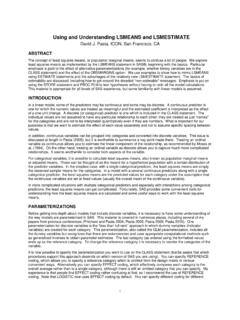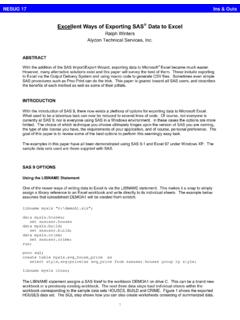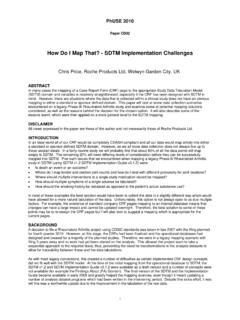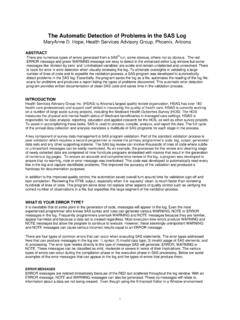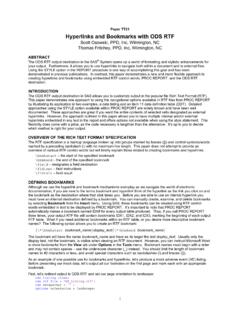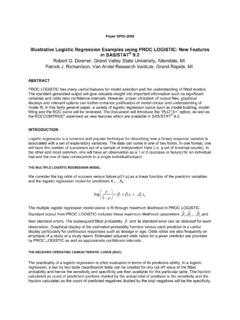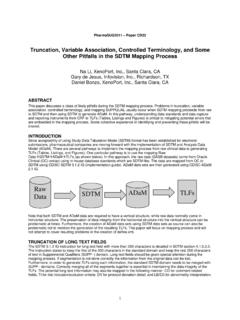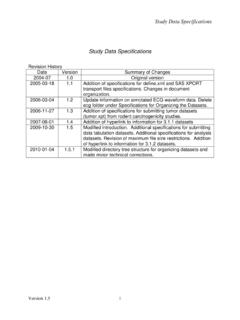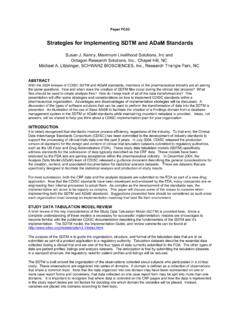Transcription of Define-XML v2 – What's New - Lex Jansen
1 PhUSE 2013 1 Paper CD05 Define-XML v2 what s New Lex Jansen , SAS Institute Inc., Cary, NC, USA ABSTRACT In March 2013 the final version of the Define-XML standard [1], formerly known as CRT-DDS (Case Report Tabulation data Definition Specification) or , as most people called it, was released by the CDISC XML Technologies team. Define-XML is a major revision of the Define-XML standard for transmission of SDTM, SEND and ADaM metadata. Version was released for implementation in February 2005 [2]. Define-XML has been a useful mechanism and critical component for providing Case Report Tabulation data Definition Specifications (CRT-DDS) in an XML format for CDISC based electronic submissions to a regulatory authority such as the Food and Drug Administration (FDA). The Define-XML specification has been greatly improved with an increased clarity and reduced ambiguity. This paper gives an overview of changes between the 2 versions and the new features of Define-XML Keywords: CDISC, CRT-DDS, Define-XML , , metadata INTRODUCTION This paper describes an updated Define-XML version model that is used to describe CDISC SDTM (Study data Tabulation model ), SEND (Standard for Exchange of Nonclinical data ) and ADaM (Analysis data model ) datasets for the purpose of submissions to the FDA, as well as any proprietary (non-CDISC) dataset structure.
2 Define-XML version can be used to transmit metadata for the following CDISC standards: SDTM Implementation Guide Versions and higher ADaM Implementation Guide Versions and higher SEND Implementation Guide Versions and higher Note: The official name for Define-XML version is CRT-DDS (Case Report Tabulation data Definition Specification) version In this paper we will refer to this version as Define-XML version 1. This paper assumes that the reader is familiar with some basic XML concepts, and also with Define-XML version Reference [3] contains both a short overview of the XML needed to understand this paper, and also an overview of the structure of a file based on Define-XML version When submitting clinical study data in electronic format to the FDA, or other regulatory agencies, not only information from trials has to be submitted, but also information to help understand the data .
3 Part of this information is a data definition file, which is the metadata describing the format and content of the submitted data sets. When submitting data in CDISC format it is required to submit the data definition file in the Case Report Tabulation data Definition Specification format ( ) as prepared by the CDISC team [4]. In August 2013 the FDA has also started accepting Define-XML version [5]. A file, or data definition specification, provides different kinds of metadata for: Datasets: - Name, label, class, structure, purpose, keys, location, comments, documentation Variables: - Name, label, type, length, codelist, origin, derivations, comments Variables under a condition: - Value level metadata or parameter value level metadata Controlled Terminology: - Standard or sponsor defined, valid values, decodes Derivations or Algorithms Links to submission files: - Annotated CRF, Reviewers' Guide, data sets, PhUSE 2013 2 OPERATIONAL data model The Define-XML standard is based on the CDISC Operational data model (ODM) XML schema [6].
4 The new Define-XML version 2 takes full advantage of the latest ODM version The CDISC Operational data model is a vendor neutral, platform independent XML format for interchange and archival of clinical study data . The model represents study metadata, administrative metadata, reference data and subject data associated with a clinical trial. The ODM format is defined by an XML schema and a specification. One of the features of the ODM is a standardized mechanism for defining schema extensions to provide functionality needed to support interchange requirements for specialized use cases. To address the specific needs of data transmission in support of regulatory submissions, CDISC has developed the Define-XML model , which is implemented as an extension to the ODM foundation schema. These extensions follow the guidelines for Vendor Extensions provided in the ODM specification and comply with the W3C XML Schema specification.
5 The XML schema files for the Define-XML standard are available online [4]. Figure 1 depicts the extension mechanism. Figure 1 Define-XML v2 as an ODM extension WHY A NEW VERSION? Although Define-XML version 1 has been a successful standard since 2005, there were good reasons to publish a new version. Some of the early goals for Define-XML version 2 were: Put Define-XML on an ODM platform, as to better enable support for CDISC standards like ADaM, and not just Case Report Tabulations ( SDTM and SEND). ODM introduced better support, in a machine readable way, for Controlled Terminology ( EnumeratedItems), derivations, formal expressions (Methods) and comments. Improve the clarity of the specification by providing more examples and less ambiguity. More explicit support for document references. Improving the support for machine readable value level metadata or parameter level metadata.
6 Although in Define-XML version 1 there was already support for value level metadata, it was incomplete and not explicit. Provide more metadata for Controlled Terminology enabling the designation of a codelist as CDISC Controlled Terminology. Implement best practices by SDTM and ADaM metadata experts. The next sections will show more detail of the new Define-XML version 2 features. DEPRECATED COMPONENTS Some components of Define-XML version 1 have been deprecated to enable the utilization of existing ODM components. A list of the deprecated elements and attributes is provided in table 1. PhUSE 2013 3 Table 1 Deprecated components Element(s) Component Comment MetaDataVersion def:ComputationalMethod Replaced by ODM MetaDataVersion/MethodDef element. ItemGroupDef def:Label Replaced by ODM ItemGroupDef/Description element. ItemGroupDef def:DomainKeys Replaced by ODM ItemGroupDef/ItemRef/@KeySequence attribute.
7 ItemDef def:Label Replaced by ODM ItemDef/Description element. ItemDef def:ComputationMethodOID Replaced by ODM ItemRef/@MethodOID attribute ItemDef Origin Replaced by new ItemDef/def:Origin element. ItemDef Comment Replaced by ItemDef/@def:CommentOID attribute and MetaDataVersion/def:CommentDef element CodeListItem def:Rank Replaced by ODM attribute Rank. Example 1 shows some of the changes mentioned in Table 1, specifically in a data set definition. Notice the Method reference on the ItemRef element in Define-XML version 2. In Define-XML version 1 Computational Methods were referenced from ItemDef elements. Example 1 Deprecated components in a data set definition LINKING TO SUPPORTING DOCUMENTS Define-XML version adds support to explicitly link to external documents. These can be links to the Annotated Case Report Form, Supplemental Documents or other supporting documents, such as data Guides.
8 Page numbers, page ranges or named destinations within the PDF document can be specified in a machine readable way. Parsing of strings like CRF Pages 23, 24 and 25 will no longer be needed! These document links can be attached to various metadata elements: data sets, as a reference in a comment data set variables, as a reference in a comment or related to the origin (Annotated Case Report Form) Methods or derivations can include references to documents. In Define-XML version 1 links to a document would be defined like the following example (example 2): <!-- Dataset Definition (DM) ( Define-XML version 1) --> <ItemGroupDef OID=" " Name="DM" Repeating="No" IsReferenceData="No" Purpose="Tabulation" def:Label="Demographics" def:Structure="One record per event per subject" def:DomainKeys="STUDYID, USUBJID" def:Class="Special Purpose" def:ArchiveLocationID=" "> <ItemRef ItemOID="STUDYID" OrderNumber="1" Mandatory="Yes" Role="Identifier"/> <ItemRef ItemOID="DOMAIN" OrderNumber="2" Mandatory="Yes" Role="Identifier"/> <ItemRef ItemOID="USUBJID" OrderNumber="3" Mandatory="Yes" Role="Identifier"/> <ItemRef ItemOID="SUBJID" OrderNumber="4" Mandatory="Yes" Role="Topic"/> <!
9 -- Dataset Definition (DM) ( Define-XML version 2) --> <ItemGroupDef OID=" " Domain="DM" Name="DM" Repeating="No" IsReferenceData="No" SASD atasetName="DM" Purpose="Tabulation" def:Structure="One record per subject" def:Class="SPECIAL PURPOSE" def:CommentOID=" " def:ArchiveLocationID=" "> <Description> <TranslatedText xml:lang="en">Demographics</TranslatedText> </Description> <ItemRef ItemOID=" " OrderNumber="1" Mandatory="Yes" KeySequence="1"/> <ItemRef ItemOID=" " OrderNumber="2" Mandatory="Yes"/> <ItemRef ItemOID=" " OrderNumber="3" Mandatory="Yes" KeySequence="2" MethodOID=" "/> <ItemRef ItemOID=" " OrderNumber="4" Mandatory="Yes"/> PhUSE 2013 4 Example 2 Document references in Define-XML version 1 (or actually, the lack thereof ..) When viewing the file in a browser, the supporting XSL stylesheet was then expected to create links to the correct pages (6, 7 and 8) in the Annotated Case Report Form ( ) or to a named destination ( ) in a document ( ).
10 Whether this would work would depend on undocumented and implicit conventions and a lot of programming in the XSL stylesheet. There is no machine readable connection between the source (Origin and Comment) and the target of the link. In Define-XML version 2 this is much more explicit, as the following example shows: Example 3 Explicit document references in Define-XML version 2 <ItemDef .. <def:Origin Type="CRF"> <def:DocumentRef leafID=" "> <def:PDFPageRef PageRefs="6 7 8" Type="PhysicalRef"/> </def:DocumentRef> </def:Origin> </ItemDef> <ItemDef OID=" " .. CommentOID=" " .. </ItemDef> <def:CommentDef OID=" "> <Description> <TranslatedText xml:lang="en"> Derived from arm code in TRIAL ARM (TA) based on Randomization Number. See Note </TranslatedText> </Description> <def:DocumentRef leafID=" "> <def:PDFPageRef PageRefs=" " Type="NamedDestination"/> </def:DocumentRef> </def:CommentDef> <def:leaf ID=" " xlink:href=" "> <def:title>Annotated Case Report Form</def:title> </def:leaf> <def:leaf ID=" " xlink:href=" "> <def:title>Reviewers Guide</def:title> </def:leaf> <def:AnnotatedCRF> <def:DocumentRef leafID="blankcrf"/> </def:AnnotatedCRF> <def:SupplementalDoc> <def:DocumentRef leafID="ReviewersGuide"/> </def:SupplementalDoc> <def:leaf ID=" " xlink:href=" "> <def:title>Annotated Case Report Form</def:title> </def:leaf> <def:leaf ID=" " xlink:href=" "> <def:title>Reviewers Guide</def:title> </def:leaf> <ItemDef.



